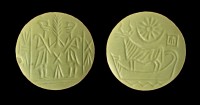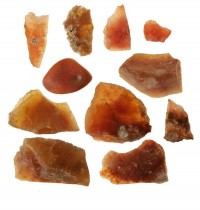 Archaeologists have discovered a 3,500-year-old jewelry workshop on the island of Failaka off the coast of Kuwait. Failaka was one of the major hubs of the Bronze Age Dilmun civilization, which at its peak is believed to have covered parts of modern-day Bahrain, Kuwait, Qatar and coastal Saudi Arabia. From around 2000 B.C., Dilmun held the monopoly on trade in the Persian Gulf. Failaka’s position at the entrance to Kuwait Bay gave it outsized strategic significance.
Archaeologists have discovered a 3,500-year-old jewelry workshop on the island of Failaka off the coast of Kuwait. Failaka was one of the major hubs of the Bronze Age Dilmun civilization, which at its peak is believed to have covered parts of modern-day Bahrain, Kuwait, Qatar and coastal Saudi Arabia. From around 2000 B.C., Dilmun held the monopoly on trade in the Persian Gulf. Failaka’s position at the entrance to Kuwait Bay gave it outsized strategic significance.
Dilmun’s ascendance wasn’t uninterrupted. Somewhere around the year 1700 B.C., the well-established trade network collapsed. The temples and cities were abandoned and the tombs of the kings looted. The next century is known as a dark age for Dilmun and Failaka because whatever the cause and effects of the collapse, there is little in the archaeological record that might shed light on the period.
 The jewelry workshop is therefore something of a grail-shaped beacon. It was discovered in a building dated to the period between 1700 and 1600 B.C. and it contains very important garbage: small fragments of semi-precious stones including carnelian and jasper discarded as waste. Carnelian and jasper and not native to Failaka. These were imports, probably from Indian and Pakistan, which means trade across vast distances was still active during the so-called dark ages.
The jewelry workshop is therefore something of a grail-shaped beacon. It was discovered in a building dated to the period between 1700 and 1600 B.C. and it contains very important garbage: small fragments of semi-precious stones including carnelian and jasper discarded as waste. Carnelian and jasper and not native to Failaka. These were imports, probably from Indian and Pakistan, which means trade across vast distances was still active during the so-called dark ages.
Kristoffer Damgaard, an assistant professor in the department of Cross-Cultural and Regional Studies at the University of Copenhagen, believes that Højlund and his colleagues have made an important discovery.
“I have no doubt that this is an important and historically crucial discovery,” said Damgaard. “These are the raw materials for luxury items for the wealthy that reveals the local elite had the option of long-distance trading in commodities such as precious stones.”
Damgaard said that the find is an “example of how far back globalisation extends”. Højlund believes that the stones show that Kuwait resumed trade during the dark period.
“Kuwait must have re-established the trade routes that collapsed around the year 1700 BC,” he said. “It bears witness to a renaissance in Bahrain and Failaka in around 1600 BC, when it resumed relations eastward to Pakistan and India.”
It’s also relevant to Failaka’s particular archaeological record because Dilmun was known for its circular stamped seals (as opposed to ones that were rolled like the cylinders of Mesopotamia). Dilmunian seals have been unearthed in India, Mesopotamia and in Failaka. A great number of them were found in a square stone building in the Al Hakim Palace and Tower Temple complex. They were of different shapes and sizes — circular, rectangular, square, cylinder scarab-shaped — and bore different inscriptions. The sheer numbers and variety of seals found on Failaka underscore that it was a pivot point of cultural exchange between the civilizations of the Gulf.
Danish archaeologists from the Moesgaard Museum, led by Peter Vilhelm Glob famed as the archaeologist who examined the bog body Tollund Man upon its discovery by peat cutters in 1950, were the first to systematically excavate the Persian Gulf countries in the southern Arabian peninsula beginning in 1953. Glob’s team found the first evidence of the Dilmun civilization in Bahrain and thought it was a local power. When they were invited to excavate Kuwait in 1958, they found Dilmun’s reach extended north as well, that they had colonized Failaka around 2,000 B.C. and used as a political, economic and religious center and headquarters for shipping. This most recent series of excavations on Failaka have been ongoing for nine years.
This week is just a treasure trove of great stories about fascinating digs. Dig it! 😀
Not that I had read it myself, but what elsewhere has been dubbed as “Glob on Bogs” seems to have been a standard work** on ‘bog bodies’ back then.
That sort of token from Dilmun, by the way, with what appears to be a ship with cattle and two people standing in a field with ears of wheat and sheafs, looks gorgeous. Its design could almost appear on modern coins.
—————
Epic of Gilgamesh, tablet 11, the story of the flood: “… The hearts of the Great Gods moved them to inflict the Flood. […] O man of Shuruppak, son of Ubartutu: Tear down the house and build a boat! Abandon wealth and seek living beings! Spurn possessions and keep alive living beings! Make all living beings go up into the boat. The boat which you are to build, its dimensions must measure equal to each other: its length must correspond to its width. …”
[Notably, only in one of the several versions, the journey seems end in Dilmun. Birds were sent and all …] “The sea calmed, fell still, the whirlwind (and) flood stopped up. I looked around all day long–quiet had set in and all the human beings had turned to clay! …” :skull:
—————
**Glob, P.V. 1969. The bog people: Iron Age man preserved. London: Faber&Faber.
Lovely stuff.
(O/T http://www.dailymail.co.uk/sciencetech/article-4159700/Treasure-hunters-discover-1-500-year-old-jewellery.html)
Naughty Zoot. You know what this calls for.
It’s great that it’s a workshop; tools tell so much more than the product.